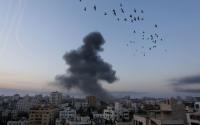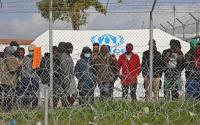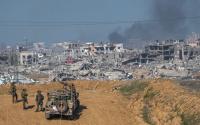24 January 2007Munir Chalabi
There is a widespread misconception in the minds of many people that the US/UK Occupation created the sectarian political map in Iraq and that the sectarian massacres only started after the occupation of Iraq.
However, a look at the history of the main political forces in Iraq, which are all based on sectarian ideologies, shows that the two main Kurdish parties (namely the KDP and the PUK) were founded in the early 1960s, while two of the main Shiite parties (the Dawa and SCIRI) were formed in the early 1980s, and the third, the Sadr movement, in 1990 -- all well before the fall of Baghdad on the 9th of April 2003.
The sectarian massacres of over 300,000 Shiites and 200,000 Kurdish civilians, whose bodies were dumped in hundreds of mass graves, took place during the 1980s/1990s by the Baathist sectarian state (and not by the Sunni community in Iraq), well before the occupation.
What the US/UK occupying forces have in fact done from day one was to deepen the divisions created by the Baathist state between the Shiites, Sunnis, and Kurds as part of their policy of "Divide and Rule."
The polices of re-Baathification of the newly formed Iraqi army and police units, were started by the US Ambassador John Negroponte and his appointed Prime Minister, the Shiite Baathist and "butcher of Najaf, Sadr City and Falluja" in 2004 -- Iyad Allawi.
Some death squads in Iraq have been under the control of the CIA and British Intelligence. One of the most lethal death squads is the so-called "Iraqi Intelligence Service," which includes over twenty thousand of the previous Shiite, Kurdish and Sunni Baathist killers, who were recalled for service from the old Baathists' security services, and are headed by the well-known Baathist General Muhammed Abdulla Al-Shahwani, who was head of the Iranian affairs committee within the Baath party. This organization is completely controlled and financed by the CIA in Baghdad.
When did the Iraqi Baath party turn into a sectarian party?
The Iraqi Baath party was formed in Iraq in the early 1950s, as an extremist Nationalist Arab party by radical and reactionary (mainly anti-communist) Shiite and Sunni Arabs.
From the beginning, the party was anti-democratic and soon after its formation it turned into a fascist organization with an ideology which believed in reaching political power by all non-democratic means. This included the assassination of any political opponents and co-operation with any external superpower that would enable them to take control of the state.
The Baath party had a mixture of Shiite and Sunni leadership and policy makers in the fifties and up to the coup of 1963. Ali Salih Al-Sadi, the leader of the coup, was a Shiite as were several other leaders in the party.
The turning point whereby the Shiites were removed from the leadership occurred within four years of the November 1963 coup by nationalist army officers and led to the ousting of the Baath party from power.
By the time the 1968 coup which brought the Baath Party to power for the second time occurred, Sunni policy makers were a majority of the Baathist leadership.
The sectarian struggle deepened within the party leadership after the failure of the internal coup within the party by the head of the party's security wing, the Shiite and mass killer Nadom Kisar. When he was interrogated by Saddam and Al-Baker before they killed him, he was asked why he had tried to oust them and his answer was that this leadership was turning into a sectarian anti-Shiite party.
By the 1979 Baath conference, the Saddam wing of the party succeeded in ousting all of their opponents within the "Iraqi Command" and this was the milestone which turned the party into a sectarian organization which utilized the state as the main sectarian tool against the Shiites and Kurds.
Between 1980 and 1985 the Baathist state forcibly removed from their communities over 350,000 Shiite civilians, the majority of whom were Arabs but some were Shiite Kurds (Fwellia), after confiscating all their businesses, property, money and even their Iraqi identity cards and passports. They forced them to walk through mine fields to the Iranian border where thousands of them lost their lives before the remaining survivors reached refugee camps in Iran. All of these civilians were Iraqi women, children and old men. All the young men (over 70,000 and some estimates put them at over 100,000) were arrested and then massacred and secretly dumped in the first of the hundreds of Shiite mass graves.[1]
Between 1988 and 1990 over 200,000 Kurdish civilians, mostly peasants, were taken from 2,000-3,000 villages along the Turkish and Iranian borders, which were then razed to the ground. The majority of these people where slaughtered by the Baathists' special units to create hundreds of new Kurdish mass graves and the remainder were forcibly sent to live in concentration camps in Arab areas in the south and west of Iraq. These massacres were known as the "Anfal massacres."
All the above massacres were carried out by the Baathist sectarian state for no other reason than that these people were Kurds or Shiites and occurred before the 1991 uprising.
The second stage of the State sectarian massacres was carried out after the failure of the Kurdish and Shiite uprisings in February/March 1991 in the 14 out of 18 Iraqi provinces where the majority of people were either Kurds or Shiite. The Kurds escaped the slaughter, because the Baathist government lost control of the Kurdish areas that were protected from attack by the US air bases in Turkey. The Shiite provinces of Iraq suffered the loss of over 200,000 lives, while the US and UK forces, which were occupying large parts of the south during the height of the massacres, turned a blind eye. They allowed the Baathist Special Forces to use helicopters gunships and ground-to-ground missiles to kill tens of thousands of civilians and those who were involved in the uprisings in Najaf, Karbala,Nasiriyah, Samawa, Diwaniyah and Basra.
It is important to emphasise that these sectarian massacres were carried out by the Baathist state and not by the Sunni communities.
The three Sunni provinces of Iraq did not participate in the uprising and no massacres were carried out against them.
It is also important to note that the Baathist regime killed hundreds if not thousands (no figures have been published) of Sunni opponents and Sunni individuals whom the Baathists feared would be a danger to them if they stayed alive. However, they were not killed because of their sect as was the key factor behind most massacres of Shiites and Kurds.
Conclusions
It is in the interest of the US/UK occupation to sustain the sectarian division in order to keep the enemy (the Iraqi people) divided. The formation of the US/UK-led "death squads" and over 30,000 foreign mercenaries (from so called private security companies), are the main tool used to ensure that they have a hand in directing such divisions in accordance with their interests. The objective is to keep some type of future military presence in the country, to ensure that they can reach their main goal in the occupation of Iraq -- the control of Iraqi oil production.
It is in the interest of the Baathists to continue the sectarian divisions, in order to maintain their influence on Iraqi politics. The Baathists have lost all their support and organizations in the Kurdish and Shiite areas and they are aware that they have no future there. The only way for them to keep their role in the future of Iraq is to sustain such divisions. Without it they will fade away from the political map, as was the case of many fascist movements around the globe.
It is also in the interest of the newly formed Islamic fundamentalist organizations (Al-Qaeda or their replica movements) that Iraq have such divisions. They have no environment to grow in if the sectarian divisions vanish. Their future is completely dependent on sustaining the blood bath in Iraq.
It is significant to study the "marriage of convenience" between these fundamentalist groups and the Baathists in which the Baathists provided the finance, the know-how and the hiding places and the Arab and Iraqi fundamentalists provided the suicide bombers. This was planned for during the Baath party leadership meeting in September 2003 under Saddam's guidance.[2]
All the main existing political parties and movements in Iraq are founded on sectarian ideology and many have their own militias (Kurdish, Shiite and Sunnis). These sectarian-funded movements created grounds for more sectarian fighting and cleansing in Kirkuk, Baghdad and the center of Iraq in particular after the Samarra attack in February 2006.
We should also bear in mind the involvement of the criminal gangs within all three sectors of the Iraqi society, and their participation in the kidnappings and assassinations.
All the above listed factors are contributing to the escalatingsectarian and criminal violence which is taking place in Iraq at this time. Some factors such as the occupation's death squads, the Baathists and the fundamentalists have more significance than others.
The only likely way to reduce the sectarian massacres or possibly put an end to them is if the US-led occupation starts an immediate plan to withdraw from Iraq. Then a real political reconciliation can take place between the three sectors of the Iraqi society -- excluding the Baathists and the Al-Qaeda and related fundamentalists from the political process.
For those who say that you cannot exclude the Baathists, they should study the bloody history of the Baathist party since 1958 and draw their conclusions from this. The European example should be a case for us to study. A democratic Europe would not have been possible to build after the Second World War if the Europeans had agreed to reintegrate the German Nazi party and other fascist movements in Italy and other countries in Europe within the national life of the European nations.
The recent execution of the Saddam will have some psychological and short term effects, but this will not change much on the ground as the fascist ideology of the Iraqi Baathists is the driving force behind the mass killings and there are many high-ranking Baathists who are just as vicious as Saddam, if not worse.
Notes
[1] These figures were stated on several Iraqi TV stations -- Al-Diar, Al-Masar and Al-Salam -- dealing with "Saddam's mass graves."
[2] The Baath party leadership meeting's declaration was published in 2004 on the website "Kitabat.com" (in Arabic). The meeting is said to have taken place in September 2003 in Anbar province, with Saddam in attendance.
Munir Chalabi is an Iraqi political analyst living in London.
http://www.zmag.org/content/showarticle.cfm?SectionID=15&ItemID=11948






